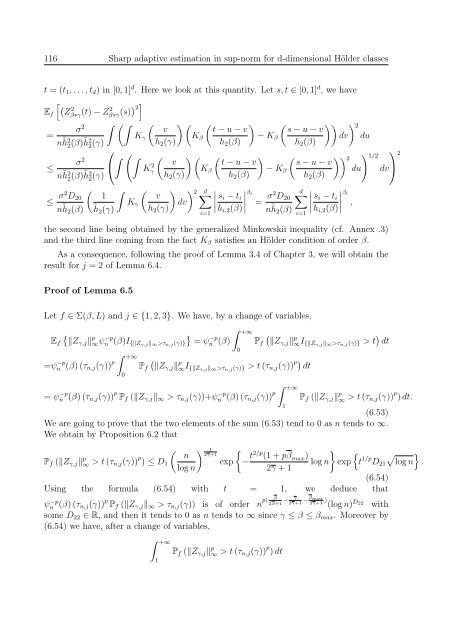THÈSE DE DOCTORAT DE L'UNIVERSITÉ PARIS 6 Spécialité ...
THÈSE DE DOCTORAT DE L'UNIVERSITÉ PARIS 6 Spécialité ...
THÈSE DE DOCTORAT DE L'UNIVERSITÉ PARIS 6 Spécialité ...
- No tags were found...
Create successful ePaper yourself
Turn your PDF publications into a flip-book with our unique Google optimized e-Paper software.
116 Sharp adaptive estimation in sup-norm for d-dimensional Hölder classest = (t 1 , . . . , t d ) in [0, 1] d . Here we look at this quantity. Let s, t ∈ [0, 1] d , we haveE f[ (Z2β∗γ (t) − Z 2 β∗γ(s) ) 2 ]σ 2 ∫ (∫ ( v=Kn˜h 2 2(β)˜h 2 γ2(γ)h 2 (γ)⎛σ 2 ∫ ( ∫≤⎝ Kn˜h 2 2(β)˜h 2 γ22(γ)( ∫≤ σ2 D 20 1n˜h 2 (β) ˜h 2 (γ)) ( ( ) ( )) 2 t − u − v s − u − vK β − K β dv)duh 2 (β)h 2 (β)( ) ( ( ) ( )) 2 v t − u − v s − u − vK β − K β duh 2 (γ) h 2 (β)h 2 (β)( ) ) 2 d∑ vK γ dvh 2 (γ)i=1β s i − t ii ∣h i,2 (β) ∣ = σ2 D 20n˜h 2 (β)d∑s i − t i∣∣h i,2 (β)i=1∣β i,) 1/2dv⎞the second line being obtained by the generalized Minkowskii inequality (cf. Annex .3)and the third line coming from the fact K β satisfies an Hölder condition of order β.As a consequence, following the proof of Lemma 3.4 of Chapter 3, we will obtain theresult for j = 2 of Lemma 6.4.Proof of Lemma 6.5⎠2Let f ∈ Σ(β, L) and j ∈ {1, 2, 3}. We have, by a change of variables,{ }E f ‖Zγ,j ‖ p ∞ψn−p (β)I {‖Zγ,j ‖ ∞>τ n,j (γ)} = ψ−pn (β)=ψ −p∫ +∞∫ +∞n (β) (τ n,j (γ)) p (P f ‖Zγ,j ‖ p ∞I {‖Zγ,j ‖ ∞ >τ n,j (γ)} > t (τ n,j (γ)) p) dt0∫ +∞= ψn−p (β) (τ n,j (γ)) p P f (‖Z γ,j ‖ ∞ > τ n,j (γ))+ψn −p (β) (τ n,j (γ)) p0P f(‖Zγ,j ‖ p ∞I {‖Zγ,j ‖ ∞>τ n,j (γ)} > t ) dt1P f (‖Z γ,j ‖ p ∞ > t (τ n,j (γ)) p ) dt.(6.53)We are going to prove that the two elements of the sum (6.53) tend to 0 as n tends to ∞.We obtain by Proposition 6.2 that( ) 1}nP f (‖Z γ,j ‖ p ∞ > t (τ n,j (γ)) p 2γ+1) ≤ D 1 exp{− t2/p (1 + pβ max )√ }log n exp{t 1/p D 21 log n .log n2γ + 1(6.54)Using the formula (6.54) with t = 1, we deduce thatψn −p (β) (τ n,j (γ)) p P f (‖Z γ,j ‖ ∞ > τ n,j (γ)) is of order n p( β− γ2β+1 2γ+1 − β max2γ+1 ) (log n) D 22withsome D 22 ∈ R, and then it tends to 0 as n tends to ∞ since γ ≤ β ≤ β max . Moreover by(6.54) we have, after a change of variables,∫ +∞1P f (‖Z γ,j ‖ p ∞ > t (τ n,j (γ)) p ) dt










